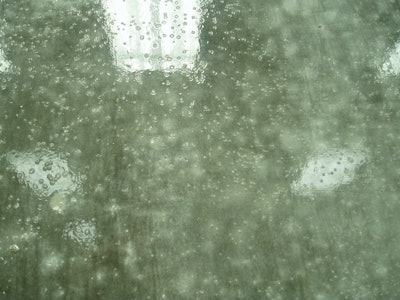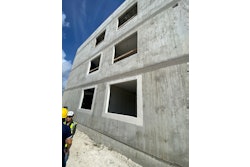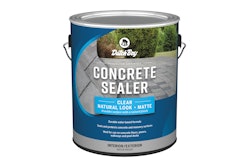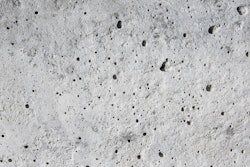
What happened?
The solvent-based acrylic sealers in both these photos failed due to over application. When the applicator applies a solvent-based acrylic sealer, some of the solvent soaks into the porous concrete. If the application is too thick, or if too many layers are applied, the solvent is not able to evaporate before the sealer skins over, or creates a seal. When that happens, the solvent gets trapped and eventually creates enough pressure that it forces its way out from under the skinned over sealer. The pressure causes the sealer to bubble, as you see on the left, or in extreme cases, as on the right, it blasts the sealer off the surface off the concrete.
Whose fault was it?
The contractors on both these jobs applied too much sealer, either by applying one very thick coat or by applying too many subsequent coats.
Prevent this from happening to you.
“The temptation is to put on one thick coat when the customer asks for a glossy look or the contractor wants to save some time,” says Jennifer Crisman with Euclid Chemical Company. “But more isn’t always best. Problems happen when you apply too much sealer.”
First and foremost, always follow the manufacturer’s recommendations. The product instructions will include the spread rate (typically expressed in square feet per gallon) and recommended application equipment. In general, a manufacturer will recommend two to three thin coats and designate a maximum number of coats that a contractor should not exceed.
Not all concrete is the same, which means the same sealer on different slabs can require a different number of coats. The contractor will also notice different coverage rates between the first and second coats, which will be addressed in manufacturer specifications.
Allow each layer to dry between coats. Drying time is dependent on the product, ambient temperature, wind and humidity. “The second coat may be applied when the first coat is tack free — that could take between 15 minutes and several hours,” Crisman advises.
So how does a contractor know when he has enough sealer? It’s an appearance issue that starts with the contractor finding out what the owner wants — a matte finish, glossy finish or something in between. “The contractor should apply the first coat at the manufacturer’s specified application rate, let it dry and see how it looks,” Crisman suggests.
And remember, all roads lead back to the product literature — read and follow your manufacturer recommendations.




















